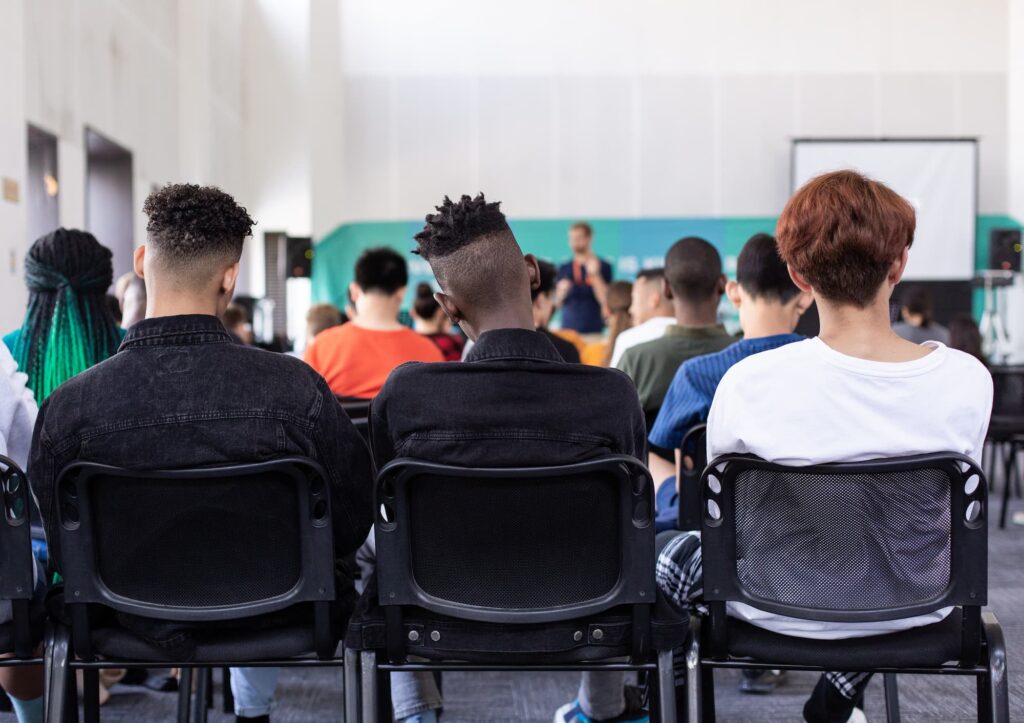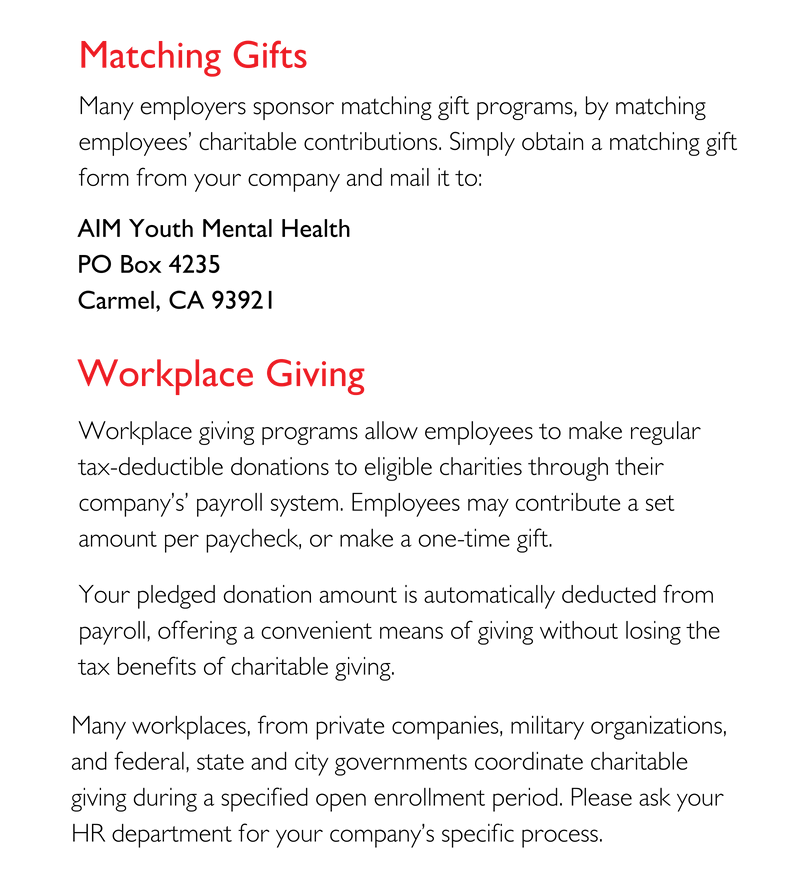

By Meadowlark Monaghan, AIM Youth Advisory Board Member
With the arrival of another school year, it’s more apparent than ever how young people are facing challenges that even adults aren’t sure how to handle. While some students may be eager to get back to see their friends and dive into new routines and activities, others may be feeling some serious trepidation about who they are going to eat lunch with and how they are going to make it through AP World History amidst the backdrop of a lingering pandemic, gun violence, and social unrest. Understandably so, it’s important for youth and parents alike to keep in mind the varying emotions that come alongside another term.
Stress, social anxiety, depression, and low self-worth are just some of the major challenges for teens and adolescents—as outlined in our AIM Ideas Lab 2023 Report. After all, 17% of youth (ages 6-17) experience a mental health disorder, with half of all mental health disorders beginning in individuals’ mid-teen years and 75% of mental health conditions presenting by age 25. In addition to these harrowing statistics, as of June 2022, 56% of 11-13 year olds who took a depression screen in the U.S. reported experiencing frequent suicidal ideation, which was the highest rate of any age group.
Youth are going back to school amongst a throng of social, political, and environmental issues that previous generations may not even be able to relate to. Therefore, setting you and your family up for a mentally healthy school term involves intentional space holding and integration into daily life. Today, we’re helping you with some great places to start: stress management, structured routines, and connection to community.
The Optimal Level of Stress
Between a changing schedule, new teachers, new social dynamics, academic demands, and extracurricular activities—the pressure students feel these days can certainly pile on the stress. Unfortunately, that stress can bring with it some significant harm to academic performance. Unmanaged stress can lead to attention and memory challenges, social withdrawal, anxiety, emotional exhaustion, and higher absences.
Luckily, research has shown that coping strategies and self-efficacy are two of the most impactful factors to promoting student engagement, persistence, and academic success. Particularly interesting, being flexible with coping strategies is one sure-fire way to improve a student’s self-efficacy or belief in their capacity to act in the ways necessary to reach specific goals. It’s not enough to simply engage in self care; caring for ourselves and believing in our ability to accomplish our goals takes open-mindedness and adaptability in our self care routines.
It’s worth it to mention that school stress may not always be an issue since stress itself isn’t always an issue. In fact, some stress is good! Stress has the ability to build our resilience and is necessary for our growth and peak performance, that is, when it feels manageable. With feelings of low self-confidence plaguing many of our youth, the ability to work through manageable stress and accomplish tasks can help to build self trust and conviction. It’s when that stress reaches the other side of the Stress Curve—into unmanageable territory—that requires bringing ourselves back to an optimal level of stress through coping.
Whether responding to unmanageable stress or participating in routine self care, one stress management practice that every smartphone-attached-youth can get behind is keeping an active Coping Strategies List in the Notes App.
Waking up to a stressful day ahead is already overwhelming enough without the added pressure of figuring out how to take care of yourself that day. By keeping an ongoing list of coping strategies, figuring out how to care for yourself becomes one less thing to worry about.
Each time a friend mentions their favorite unwind activity or a self care vlog graces your FYP, jot down the coping ideas. Don’t simply include the ones that appeal to you, throw in those you wouldn’t necessarily gravitate towards as well. The truth about coping strategies is that the same ones won’t work for everyone. Even on an individual basis, what works best for us will inevitably change. Having a list allows you to keep a flexible mindset on days when you need to try something new to shake off the stressful cobwebs.
Connection To Community Is Of The Utmost Importance
While smartphones are great for self care hacks like keeping a Coping List, they are less successful in fostering social connection. One global study found school loneliness to be correlated with increases in smartphone and internet use–when countries reached a point where half of the teen population had access to smartphones, loneliness levels began to rise. Although youth are used to interacting with their peers in a digital space, youth mental health remains deeply impacted by social isolation.
These findings are replicated in the classroom as well. Just a few months into the pandemic in June 2020, a study found nearly 30% of high school youth didn’t feel at all connected to teachers, classmates, or the school community. With social isolation as a major risk factor in developing a mental health condition, like depression, remaining connected to community is more crucial than ever.
Hopefully, schools are fostering a classroom community and helping students meet over shared interests. However in addition to school efforts, facilitating connection among youth can start in the home as well. As AIM’s Ideas Lab Report shows, teens report that negative home environments, pressure from parent(s) or guardian(s), and family not acknowledging mental health issues are some of the top factors that worsen youth mental health. In response, the findings recommendation was to encourage parents to participate in family education programs about youth mental health (consider this your reminder to sign up for our Youth Mental Health First Aid Trainings) to help eliminate stigma at home.
While parents may feel called to encourage community building behaviors (like getting involved in activities outside of school or trying to start a conversation with one new person each day), it may behoove them to simply hold space for the conversation itself.
Surveyed teens expressed that they just want to be heard and are not always looking for solutions. Practicing active listening and open communication can help families to feel more connected, support destigmatization efforts in the home, and can even model emotion identification, bolstering youths’ desire to be self-reliant when it comes to their mental health by leading by example.
Make The Time For Mental Wellness
In the same way education aims to offer support through structured routine, developing routines can be particularly supportive for families experiencing adolescent mental illness. Encouraging youth to develop routines has several advantages: a sense of stability, enhanced time management, improved self-care, and better focus and productivity. While delightfully positive, establishing structure and routine may feel easier said than done for many young people.
Teens are experiencing immense pressure due to academics and feel like they don’t have the time to address their mental health. Young people are citing lack of sleep and time for self-care as some of the top factors that worsen youth mental health, with lack of time the top reason for not socializing more with their peers and having a sense of community.
Making the time for self care and connection as a family can offer youths a built-in structure of care. Relieving the individual pressure of time management for self-care is another fantastic way for parents and caregivers to get involved in their youth’s mental wellness. When practicing coping strategies together—from a “rose and thorn” dinner routine to family walks around the block—family routines act as a connection-fueled, two-for-one supportive factor in youth mental wellness. In fact, research shows that family routines function as an indicator of wellbeing for the adolescent, providing stability in times of stress, protecting their wellbeing, and supporting the expression of identity.
Rather than asking our youth to mitigate self coping on their own schedule, baking mental wellness into our family conversations, routines, and quotidian moments impact their mental health exponentially. There is no “end” to caring for our mental health—it’s a lifelong journey that requires flexibility, open-mindedness, and commitment. If one thing is for certain, it’s that this never ending process is made a lot easier when we practice it together. This back to school season, bring your family in on the process.
For parents or caregivers looking to expand their knowledge, please join us for one of AIM’s upcoming Youth Mental Health First Aid Trainings. Become part of the solution for caring for our next generation’s mental wellness.
______________________
About the Author
Meadowlark Monaghan (she/hers) is a consultant using her knowledge gained as a mental health professional to act as a liaison between brands, creators, + online communities with the field of psychology and mental health. She also co-hosts the personal development podcast, Thoughts May Vary. Her work has been seen with Madhappy, Local Optimist, The Mayfair Group, Lonely Ghost, AIM Youth Mental Health, NAMI San Diego and more.


















 Moving Upstream: A Proactive Approach to Addressing Behaviors and Bullying
Moving Upstream: A Proactive Approach to Addressing Behaviors and Bullying Krista Reuther is the Assistant Director of Ohana’s Community Health and Prevention Program. She received her Masters in Public Health and Social Work at UC Berkeley. She comes to this position after 14 years of clinical social work experience at Stanford Children’s Hospital in pediatric oncology, critical care, and bereavement. Her goal is to reduce the incidence of mental illness in children and adolescents in Monterey County.
Krista Reuther is the Assistant Director of Ohana’s Community Health and Prevention Program. She received her Masters in Public Health and Social Work at UC Berkeley. She comes to this position after 14 years of clinical social work experience at Stanford Children’s Hospital in pediatric oncology, critical care, and bereavement. Her goal is to reduce the incidence of mental illness in children and adolescents in Monterey County. Dr. Guss is a 35-year veteran educator with a doctorate degree in Educational Leadership. She served as a classroom teacher for 10 years, including two years as a teacher in a bilingual program in South Central Los Angeles. She has also served as a college professor, mentor teacher for new teachers, and a master teacher for teacher candidates completing their student teaching experience. She continues to be a strong advocate for the teaching profession.
Dr. Guss is a 35-year veteran educator with a doctorate degree in Educational Leadership. She served as a classroom teacher for 10 years, including two years as a teacher in a bilingual program in South Central Los Angeles. She has also served as a college professor, mentor teacher for new teachers, and a master teacher for teacher candidates completing their student teaching experience. She continues to be a strong advocate for the teaching profession. Fellowship: Stanford University School of Medicine (1994) CA
Fellowship: Stanford University School of Medicine (1994) CA Michael G. Thompson, Ph.D. is a consultant, author and psychologist specializing in children and families. He is the supervising psychologist for the Belmont Hill School and has worked in more than seven hundred schools across the United States, as well as in international schools in Central America, Europe, Africa and Asia.
Michael G. Thompson, Ph.D. is a consultant, author and psychologist specializing in children and families. He is the supervising psychologist for the Belmont Hill School and has worked in more than seven hundred schools across the United States, as well as in international schools in Central America, Europe, Africa and Asia.
 is 15 years old and a sophomore at Marina High School in Marina, CA. Her academic interests include math, history, and psychology. She joined the AIM Ideas Lab in 2021 because she wanted to be a part of something that could have a great impact on her community. Marwa is interested in youth mental health because she has always been fascinated with the human mind and she wants to support those that are suffering who may feel like their challenges in life aren’t important enough or are too afraid to seek necessary help.
is 15 years old and a sophomore at Marina High School in Marina, CA. Her academic interests include math, history, and psychology. She joined the AIM Ideas Lab in 2021 because she wanted to be a part of something that could have a great impact on her community. Marwa is interested in youth mental health because she has always been fascinated with the human mind and she wants to support those that are suffering who may feel like their challenges in life aren’t important enough or are too afraid to seek necessary help. Giovanna Panetta is a 16 year old junior at Carmel High School. She has always been called to STEM subjects, specifically biology. The AIM Ideas Lab instantly attracted her attention as a research opportunity. Gia has always comprehended the importance of mental health. She knows that COVID only exacerbated previously existing problems, and that as a community we can try and find the root of those problems. Mental health is an integral part of life, and can impede a body’s ability to be healthy. She strongly believes that life is worth living, and she wants to help anyone that thinks otherwise.
Giovanna Panetta is a 16 year old junior at Carmel High School. She has always been called to STEM subjects, specifically biology. The AIM Ideas Lab instantly attracted her attention as a research opportunity. Gia has always comprehended the importance of mental health. She knows that COVID only exacerbated previously existing problems, and that as a community we can try and find the root of those problems. Mental health is an integral part of life, and can impede a body’s ability to be healthy. She strongly believes that life is worth living, and she wants to help anyone that thinks otherwise. Dr. Friedman completed her undergraduate degree in Psychology from University of California San Diego (UCSD). She went on to complete her masters and doctorate degrees (Ph.D.) in Clinical Psychology from Rosalind Franklin University of Medicine and Science/Chicago Medical School. Dr. Friedman completed her pre-doctoral internship at Rush University Medical Center, Chicago, IL, and her post-doctoral fellowship training at the VA San Diego Healthcare System. Her clinical training and experience has been focused primarily on comprehensive assessment and effective treatments for anxiety, mood and related disorders. Dr. Friedman has extensive experience in providing Cognitive Behavioral Therapies for anxiety disorders (e.g. worry, OCD, social anxiety, phobias and PTSD), depression, adjustment disorders/life stress, insomnia and body-focused repetitive behaviors (e.g. Trichotillomania and skin picking). She has received training in evidence-based interventions for a variety of specific problems, including exposure with response prevention (ERP) for treatment of OCD, Prolonged Exposure (PE) for treatment of PTSD, and Cognitive Behavioral Therapy for Insomnia (CBT-I). Moreover, she has specialty training in the treatment of childhood anxiety and related disorders, such as ADHD, selective mutism, separation anxiety, PTSD, depression and specific phobias. In addition, Dr. Friedman has developed an expertise in research on Trichotillomania and body-focused repetitive behaviors, which has led to numerous local and national presentations. Dr. Friedman regularly attends local and national conferences, training seminars and workshops in order to stay informed on the most up to date treatments and apply state of the art science into her clinical practice.
Dr. Friedman completed her undergraduate degree in Psychology from University of California San Diego (UCSD). She went on to complete her masters and doctorate degrees (Ph.D.) in Clinical Psychology from Rosalind Franklin University of Medicine and Science/Chicago Medical School. Dr. Friedman completed her pre-doctoral internship at Rush University Medical Center, Chicago, IL, and her post-doctoral fellowship training at the VA San Diego Healthcare System. Her clinical training and experience has been focused primarily on comprehensive assessment and effective treatments for anxiety, mood and related disorders. Dr. Friedman has extensive experience in providing Cognitive Behavioral Therapies for anxiety disorders (e.g. worry, OCD, social anxiety, phobias and PTSD), depression, adjustment disorders/life stress, insomnia and body-focused repetitive behaviors (e.g. Trichotillomania and skin picking). She has received training in evidence-based interventions for a variety of specific problems, including exposure with response prevention (ERP) for treatment of OCD, Prolonged Exposure (PE) for treatment of PTSD, and Cognitive Behavioral Therapy for Insomnia (CBT-I). Moreover, she has specialty training in the treatment of childhood anxiety and related disorders, such as ADHD, selective mutism, separation anxiety, PTSD, depression and specific phobias. In addition, Dr. Friedman has developed an expertise in research on Trichotillomania and body-focused repetitive behaviors, which has led to numerous local and national presentations. Dr. Friedman regularly attends local and national conferences, training seminars and workshops in order to stay informed on the most up to date treatments and apply state of the art science into her clinical practice. Dr. Piacentini is a board-certified clinical child and adolescent psychologist and Professor in the UCLA Department of Psychiatry and Biobehavioral Sciences. He directs the UCLA Child OCD, Anxiety, and Tic Disorders Clinic and Tourette Association Center of Excellence which provide diagnostic evaluation and treatment (both therapy and medication) for youth with the above problems. He also directs the UCLA Center for Child Anxiety Resilence, Education, and Support (CARES; carescenter.ucla.edu) which provides education and programming to parents, teachers, and clinicians about anxiety prevention and management.
Dr. Piacentini is a board-certified clinical child and adolescent psychologist and Professor in the UCLA Department of Psychiatry and Biobehavioral Sciences. He directs the UCLA Child OCD, Anxiety, and Tic Disorders Clinic and Tourette Association Center of Excellence which provide diagnostic evaluation and treatment (both therapy and medication) for youth with the above problems. He also directs the UCLA Center for Child Anxiety Resilence, Education, and Support (CARES; carescenter.ucla.edu) which provides education and programming to parents, teachers, and clinicians about anxiety prevention and management. Citlalli Nava is 18 years old and a first year majoring in Psychology at Hartnell Community College in Salinas, CA. She is passionate about understanding how mental health affects how youth think, act, and feel. Citlalli joined the AIM Ideas Lab in 2021 after witnessing the increase in mental health challenges in teenagers and considering the mental health issues they are facing. Citlalli is interested in youth mental health because it is a real problem faced by her generation.
Citlalli Nava is 18 years old and a first year majoring in Psychology at Hartnell Community College in Salinas, CA. She is passionate about understanding how mental health affects how youth think, act, and feel. Citlalli joined the AIM Ideas Lab in 2021 after witnessing the increase in mental health challenges in teenagers and considering the mental health issues they are facing. Citlalli is interested in youth mental health because it is a real problem faced by her generation. Clinical and community psychologist and health care innovator Arthur C. Evans Jr., PhD, is CEO of the American Psychological Association, the leading scientific and professional organization representing psychology in the United States. With more than 146,000 researchers, educators, clinicians, consultants, and students as members, APA promotes and disseminates psychological knowledge to benefit society and improve lives – a mission consistent with Evans’ life work.
Clinical and community psychologist and health care innovator Arthur C. Evans Jr., PhD, is CEO of the American Psychological Association, the leading scientific and professional organization representing psychology in the United States. With more than 146,000 researchers, educators, clinicians, consultants, and students as members, APA promotes and disseminates psychological knowledge to benefit society and improve lives – a mission consistent with Evans’ life work.


